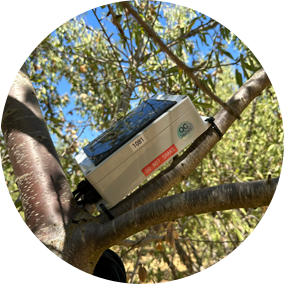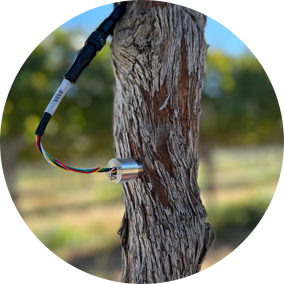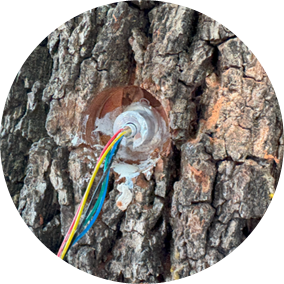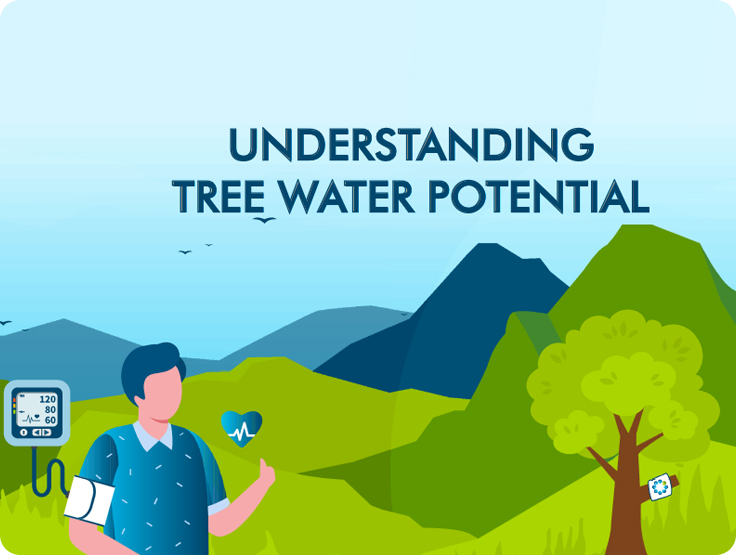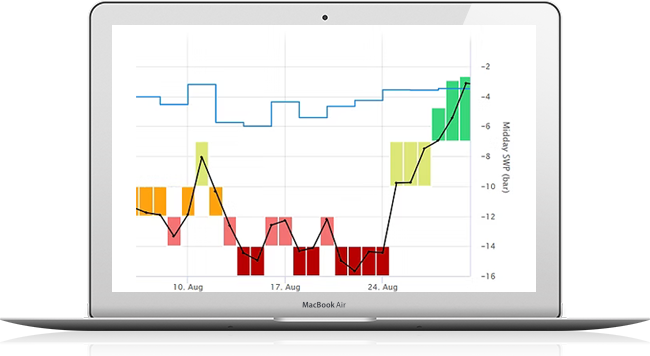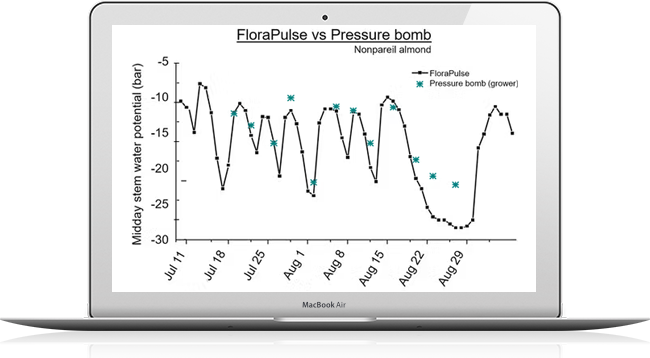About
FloraPulse
Retire the pressure chamber, know exactly when to irrigate, increase crop yield and quality.
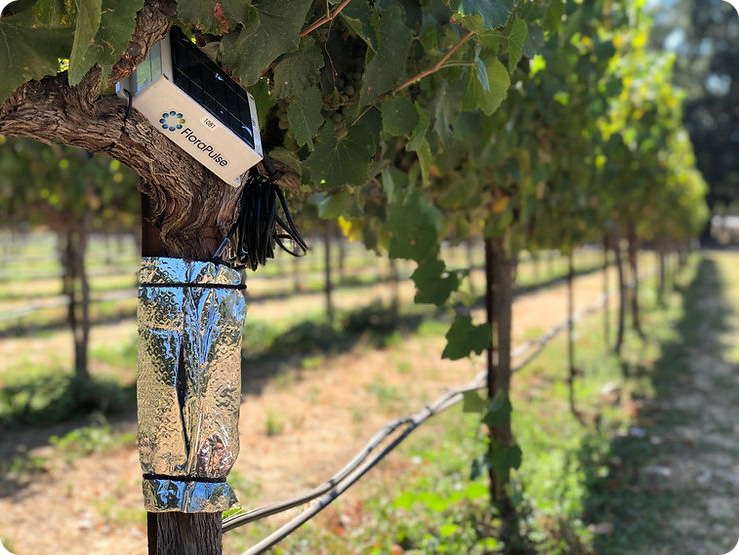
FloraPulse began in the orchards and vineyards of growers.
Since the 1970’s, Alan Lakso, professor of Horticulture at Cornell, had been dragging around the heavy, manual pressure chamber to measure and manage water stress in apple trees and grapevines. Alan was documenting the levels of water stress and their effect on fruit growth and quality. Back then, winegrape growers understood that water stress was important to wine quality, but only had the pressure chamber to measure it.
Why FloraPulse?
The Benefits of Drip Irrigation
As a seasoned horticulturist with over two decades of experience, I’ve seen the undeniable benefits of drip irrigation California offers. This method delivers water directly to the roots, minimizing evaporation and runoff, crucial in a state where water scarcity is a significant concern. Studies indicate that drip irrigation can improve water use efficiency by 20-50% compared to traditional sprinkler systems.
Drip irrigation not only conserves water but also fosters healthier plants. By maintaining consistent soil moisture levels, plants develop deeper root systems and enhance growth. Whether you’re cultivating vegetable gardens in sunny Southern California or managing vineyards in the more temperate regions, this irrigation system is a game-changer for plant health and productivity.
Moreover, the economic benefits are compelling. Although the initial investment may seem daunting, the long-term savings on water bills and the potential for increased crop yields make it a wise financial decision. Drip irrigation California systems support sustainable agriculture, ensuring the land remains productive for generations to come.
How to Set Up Your Drip Irrigation System
Setting up a drip irrigation system might seem challenging, but with the right approach, it becomes manageable. Here’s a step-by-step process to get you started:
- Select your plants: Choose the plants you intend to irrigate, considering their individual water needs.
- Design the layout: Plan the placement of your drip lines, keeping in mind the spacing and water flow required for each plant.
- Gather materials: Acquire essential components like tubing, emitters, filters, and pressure regulators.
- Install the tubing: Lay out the main line and lateral tubing close to the plants.
- Connect the emitters: Attach emitters close to the plant base, adjusting the type and flow rate as necessary.
- Test the system: Run water through the setup to ensure that there are no leaks and that each plant receives adequate water.
Once installed, monitor the system regularly to make sure it’s functioning optimally. Adjust water delivery based on plant growth and seasonal changes.
Essential Tips for Drip Irrigation Success
From my experience, there are several best practices to keep in mind when using drip irrigation systems. Firstly, always use a filter to prevent clogging, which is a common issue in areas like California with hard water. A pressure regulator is also vital to maintain consistent water flow across the system.
Check your emitters regularly. It’s easy for them to get clogged or damaged, especially in dusty or windy environments. I recommend doing a complete system check at least every month.
- Ensure emitters are placed correctly and functioning.
- Regularly flush the lines to clear out debris.
- Adjust the water schedule according to seasonal weather changes.
- Consider soil type when planning your system layout.
Incorporating these tips into your regular maintenance routine will ensure your drip irrigation system operates at peak efficiency, contributing to healthier plants and more bountiful yields.
Common Misconceptions about Drip Irrigation California
Despite its advantages, there are several misconceptions about drip irrigation California that need addressing. One common fallacy is that it’s too expensive or complicated for small gardens. However, modern systems are modular and can be tailored to fit any space, from residential gardens to large commercial fields.
Another misconception is that drip irrigation systems are maintenance-free. While they require less upkeep than other systems, regular inspections for leaks and clogs are crucial. The time and effort invested in maintenance are minimal compared to the benefits of efficient water use and plant health.
Some growers believe drip systems can’t handle irregular landscapes. On the contrary, they are perfect for such conditions, as they deliver precise amounts of water, even on slopes or areas with variable soil conditions.
Understanding and dispelling these myths will lead more people to adopt this sustainable irrigation method, greatly benefiting agriculture in California.
What Qualifies as a Drip Irrigation California Emergency?
An irrigation emergency in California typically involves sudden disruptions that threaten crop health, such as a major leak or clog in the system. Responding quickly is crucial to prevent extensive water waste or damage to plants.
If you encounter a pressure loss or notice areas in your field drying out rapidly, these are signs of potential system failure. Address these issues by checking the main water line, ensuring connections are secure, and cleaning or replacing faulty emitters.
For immediate assistance, reaching out to a professional experienced in drip irrigation California can provide quick resolution, ensuring your crops remain hydrated and thriving.
The Future of Drip Irrigation California
As we look to the future, it’s clear that drip irrigation California is evolving alongside technological advancements. Companies like FloraPulse are at the forefront, integrating precise irrigation recommendations with cutting-edge sensor technology to optimize water use. This approach not only enhances crop yield and quality but also aligns with California’s strict water management policies.
The shift towards data-driven irrigation solutions is set to continue. Growers will increasingly rely on technologies that provide real-time insights into crop water needs, allowing for precise, efficient irrigation practices. It’s an exciting time to be involved in agriculture, and drip irrigation California will undoubtedly play a pivotal role in the sustainable farming practices of tomorrow.
What are the main benefits of using drip irrigation systems in California agriculture?
Drip irrigation systems offer a host of benefits, particularly in California where water scarcity is a pressing issue. This method is highly efficient, directly delivering water to the plant roots and significantly reducing evaporation and runoff compared to traditional methods. Notably, studies have shown improvements in water use efficiency by 20-50%. This translates to healthier plants with deeper roots, which is essential for robust growth. Economically, while the initial setup can be costly, the long-term savings on water bills and increased crop yields make it a financially sound choice. Drip irrigation aligns with sustainable agricultural practices, ensuring long-term productivity of the land.
How should one go about setting up a drip irrigation system effectively?
Setting up a drip irrigation system may seem daunting, but breaking it down into steps simplifies the process. Start by selecting the plants and understanding their water needs. Design your layout carefully to ensure efficient coverage. Gather the necessary materials: tubing, emitters, filters, and pressure regulators. Installation involves placing the tubing close to plants and connecting emitters at the base. Always test the system to check for leaks and ensure even water distribution. Regular monitoring and adjustments based on plant growth and seasonality are crucial for optimal performance.
What are some common misconceptions about drip irrigation in California?
One of the most prevalent misconceptions is the perceived complexity and cost of drip irrigation, especially for small gardens. However, modern systems are highly modular and adaptable, making them suitable for any scale. Another myth is that these systems are maintenance-free; while less intensive than alternatives, regular checks for leaks and clogs are essential. Additionally, the idea that they are unsuitable for uneven terrain is outdated–drip irrigation excels here by delivering precise water amounts regardless of the landscape. Understanding these aspects can encourage wider adoption of this efficient method.
How does the FloraPulse system enhance drip irrigation practices for growers?
The FloraPulse system significantly enhances drip irrigation by offering precise, plant-based measurements of water stress. By using sensor technology embedded into the plant tissue, growers receive accurate daily readings and irrigation recommendations. This precision helps in making informed decisions, optimizing water use, and improving crop yield and quality. The system’s scientific validation and real-time insights empower growers to manage their irrigation more effectively, especially in crops like orchards and vineyards. Being data-driven, FloraPulse is a game-changer in sustainable irrigation efforts.
Can drip irrigation systems handle irregular landscapes effectively?
Yes, one of the strengths of drip irrigation is its ability to accommodate irregular landscapes. Whether dealing with slopes or areas with varied soil conditions, drip systems deliver precise water quantities directly to plant roots, overcoming the challenges posed by uneven terrain. This efficiency in water delivery ensures that all plants receive the necessary moisture, fostering uniform growth across challenging landscapes. If you’re dealing with such conditions, consider consulting with experts to tailor your system for optimal performance.
What should be done in case of a drip irrigation emergency in California?
In the event of a drip irrigation emergency, such as a significant leak or system failure, swift action is key. First, check for visible leaks and ensure all connections are secure. Inspect emitters for clogs or damage, and clean or replace them if necessary. Immediate attention can prevent water waste and protect plant health. For more complex issues, consulting a professional experienced in California’s specific conditions might be necessary. Quick response and regular system inspections can help keep your irrigation system running smoothly.
What advancements are expected in the future of drip irrigation in California?
The future of drip irrigation in California is set to be shaped by technological advancements. Companies like FloraPulse are leading the way by integrating sensor technology for precise irrigation recommendations. This data-driven approach aligns well with California’s stringent water management policies, offering real-time insights into crop water needs. With this technology, growers can practice more efficient irrigation, improving crop yield and quality. The trend towards smart agriculture with real-time data will likely continue, making drip irrigation a cornerstone of sustainable farming.
How It Works
How It Works
The FloraPulse system is a microchip tensiometer (microtensiometer) that is embedded into the tree woody tissue and directly measures the water status, known as water potential. Because the measurement is taken directly inside the water-carrying tissue, readings are very accurate and reliable. You receive daily midday stem water potential readings, along with science-backed irrigation recommendations.
Weekly Reports
Receive weekly reports on your crop’s water-stress history, color-coded by stress level. Use clear, detailed data to adjust your irrigation and get that perfect vintage, that perfect yield. Every year.
Scientific Validation
The sensor data has been validated against the Scholander chamber with good correlation in prune, almond, winegrape (and others).
Technology Backers

Our technology has been funded by the NSF and USDA, and was originally developed at Cornell University.
What is FloraPulse?
The most accurate way to irrigate.
Customer Testimonials
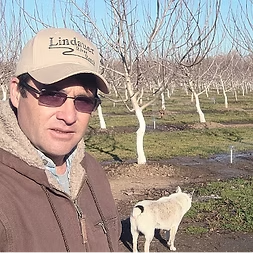

“We were extremely happy with the FloraPulse system we tested in our prune orchard this year. We found that the FloraPulse readings correlated very well with our pressure bomb readings…
Michael Vasey
Lindauer River Ranch
Red Bluff, California
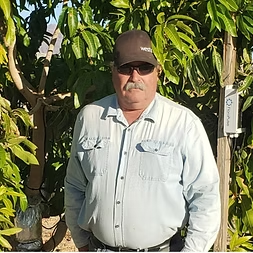

“I am very happy with the FloraPulse unit. I grow a rare mango crop, in a desert environment with extremely high summer temperatures, in alluvium soil that has very limited…
Rod Chamberlain
Wong Farms
Mecca, California


